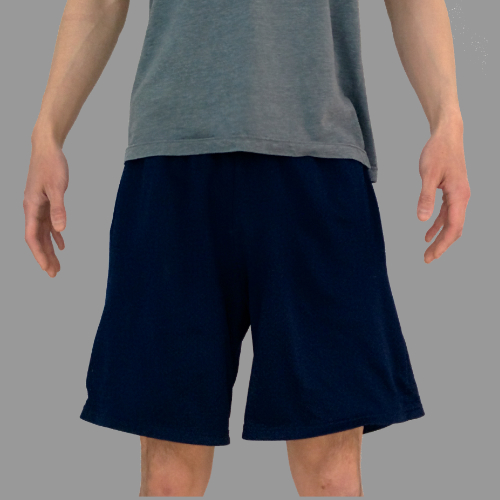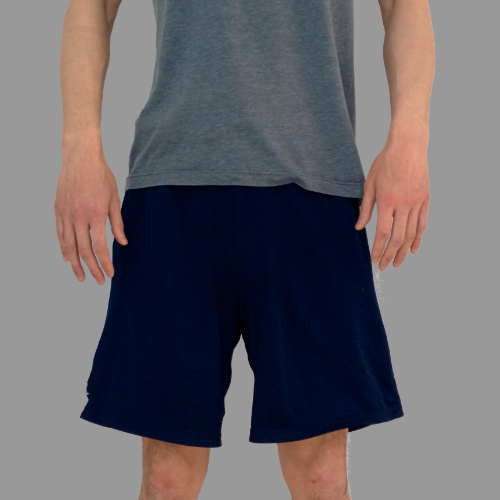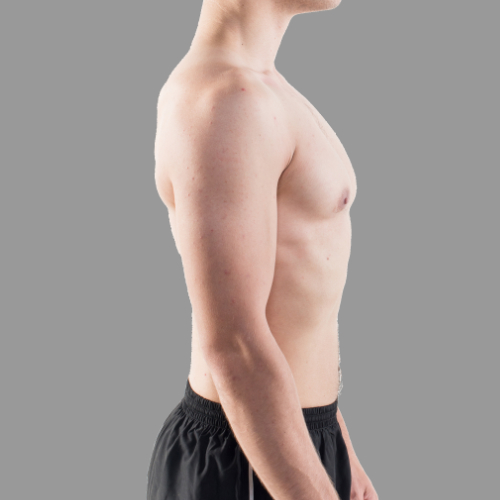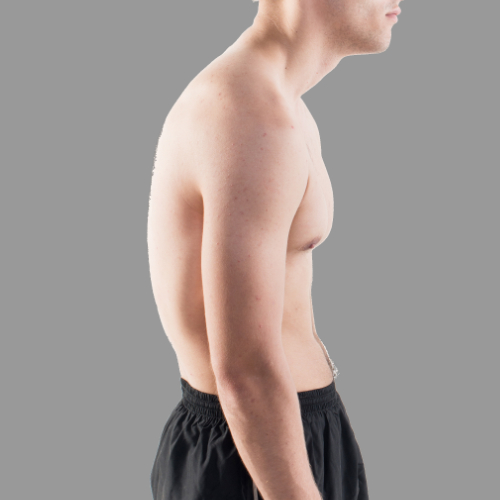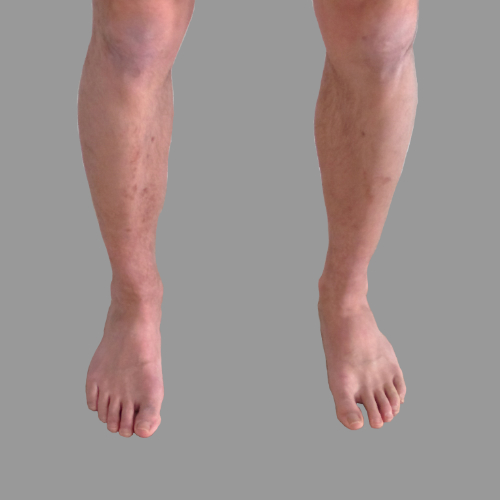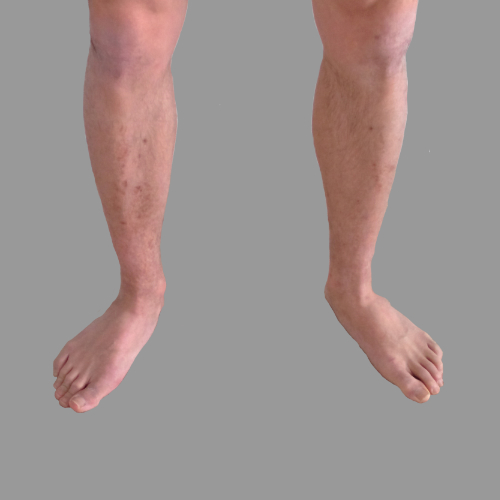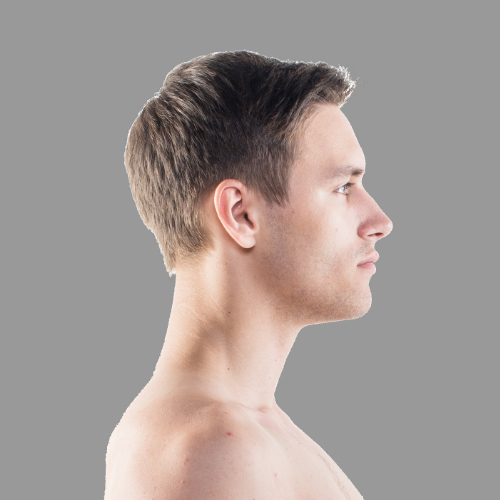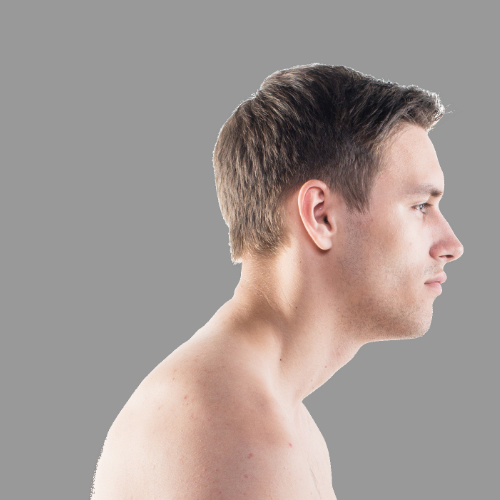This list identifies three common poor posture signs linked to sedentary occupations and lifestyles. It explores the outward signs of poor posture, the associated imbalances and asymmetries, and possible root causes behind them.
Though each person’s body-type, habits, activities, and surroundings will vary, these 3 Common Poor Posture Signs share common causes that can be traced to sedentary lifestyles and schedules.
This article also briefly discusses small measures to reduce hunching and slouching throughout the day. It also provides a quick list of exercises to address 3 Common Poor Posture Signs through overall postural improvement.
Instructions
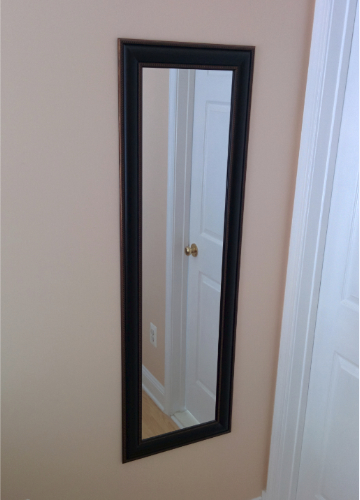
These 3 Common Poor Posture Signs are easily observable without a detailed analysis, and they do not require shirtless full-body photographs. For a more extensive survey, use a camera and tripod to capture full-body picture from the front and sides.
- Assume a standing position in front of a mirror.
- Let the body relax and assume a natural posture that requires no effort to maintain.
- Observe the hands, feet, and head & neck.
1: Rounded Shoulders
Observe the position of the hands while resting at the side.
Neutral Hands at side (Left) versus Pronated Hands in front (Right).
If the backhands can be seen with palms facing rearward, one or both hands are pronated or inwardly rotated. Pronated hands often indicate rounded shoulders.
With good posture, palms should be perpendicular to the flanks with backhands facing away from the body. At the same time, a straight line can be drawn from the shoulders down to the elbows, hips and ankles when properly aligned.
Retracted Shoulders (Left) versus Rounded Shoulders (Right).
When shoulders are rounded or rolled forward, one’s posture indicates overactive pectoral muscles and underactive upper back muscles (mid trapezius & rhomboids) along with underactive rear shoulder muscles (rear deltoids).
Upper back and rear shoulder muscles can become weak through general inactivity of the upper body and through prolonged periods of hunching and slouching. As they become weak, overactive pectoral muscles pull and rotate the shoulders toward the front of the body, creating a hunched appearance. This hunched position can eventually weaken rotator cuff muscles (teres minor) causing pain in the upper arms and numbness in the fingertips.
Muscles of the upper back can be strengthened with pulling motions such as rows, chin-ups, and exercises that recruit the upper back to stabilize presses and pushing exercises. This is highly dependent on proper movement of the shoulder blades during exercises.
2: Pronated Feet (“Duck Feet”)
Observe the angles of the feet and ankles while standing.
Normal Alignment (Left) versus Outwardly Rotated (Right).
If one or both feet are pointing away from the center line, the feet are pronated or outwardly rotated.
This sign of poor posture indicates overactive external rotators deep within the thigh that rotate the thighs away from the center line of the body. Normally, these external rotators are stabilized by internal hip rotators and muscles of the buttocks (gluteus minimus), but when weakened through inactivity, they fail to balance their connected external rotators.
Certain external rotators (gluteus medeus, gluteus maximus) serve to rotate the thigh and stabilize the legs when standing and walking while also balancing primary external rotators within the hip. These can also become weakened through inactivity further allowing external rotators to dominate the neutral position of the thigh.
This sign of poor posture can affect one’s gait while walking and running. It often requires intense training and stretching of the hips and core muscles while additionally requiring active recruitment of stabilizers to train and build proper alignment.
3: Forward Head (“Crane Neck)”
To check the position of the head, take a picture from the side profile while standing or sitting.
With good posture, the back of the neck will be flat and vertical and a straight line can be drawn from the ears downward through the shoulders, hips, and ankles when viewed from the side profile. The chin should also be down and tucked, and the mouth should not hang open.
Head Upright position (Left) versus Head-Forward position (Right).
If the neck forms a slope, then the head is in a forward position. If the head tilts behind the neck, then the neck is craning the head at its base. Both are linked to a combination of overactive neck extensors and underactive neck flexors.
Neck extensors extend the neck and push the head forward. They also tilt the head up and back from the base of the skull. These muscles are located behind the neck and move the head and neck at the base of the skull and spine.
Neck extensors can become overactive through strained lifting with a forward-head position and through regular hunching and sleeping with too many pillows under one’s head. Prolonged extensions of the neck will strain the extensors.
A forward-head position will also weaken neck flexors that flex the neck and head to an upright position. Neck flexors are located in front of the neck and serve to pull the chin down toward the chest and collarbones.
Strengthening neck flexors will relieve strain of the neck extensors, but overall posture should also be improved to prevent subconscious craning of the neck and tilting of the head. This can be accomplished directly through exercises that target the neck flexors and through proper position of the neck and head during all other exercises.
Small Measures For Great Effect
The 3 Common Poor Posture Signs in this list share mutual trends and originating habits. These can often be linked to sedentary lifestyles without proper amounts of upright physical activity causing atrophy of muscles used to stand and walk.
Sedentary occupations often furnish one-size-fits-all desks, chairs, and computer setups which encourage hunching and slouching throughout the day. To minimize the negative effects upon one’s posture from working a desk job, one should:
- Consider how many hours are spent at their desk; long hours spent at a desk require daily activity on one’s feet to eliminate the creep of poor posture.
- Plan frequent breaks to move around every 40-60 minutes.
- Reorganize one’s workspace to minimize forward hunching, leaning, and twisting.
- Use desk risers to raise monitor’s to one’s head and eye level.
- Keyboard wrist pads and mice wrist pads help keep wrists elevated to engage the arms and reduce sagging of the shoulders.
These measures will help engage muscles of the upper back, shoulders, and trunk for upright posture while sitting. A future article will detail the optimal workspace for postural health, but these quick tips should help anyone seeking to reduce hunching and slouching at their desk.
Exercises for 3 Common Poor Posture Signs
These 3 Common Poor Posture signs are linked by common occupational trends such as habitual periods of hunching and a lack of upright physical activity to counter the creep of poor posture. This is a brief list of exercises that can addresses strained and underactive muscles behind them.
ROUNDED SHOULDERS EXERCISES:
- Neutral-grip Row (Rhomboids, Lats, Rear-Delts): Resistance Band with Handles.
- 6-8 Reps for 2 Sets (Beginner).
- 8-12 Reps for 2 Sets (Advanced).
- Face Pulls (Rhomboids, Rear Delts): Resistance Band with Handles.
- 6-8 Reps for 2 Sets (Beginner).
- 8-12 Reps for 2 Sets (Advanced).
- Bentover Reverse Shoulder Fly (Rhomboids, Rear Delts): Light Dumbbells (less than 10% of body weight per Dumbbell).
- 6-8 Reps for 2 Sets (Advanced).
- 8-12 Reps for 2 Sets (Advanced).
PRONATED FEET EXERCISES:
- Hip Bridges (Glutes, Thigh Stabilizers, Core Stabilizers): No Resistance.
- 10-12 Reps for 2 Sets (Beginner).
- 12-15 Reps for 3 Sets (Advanced).
- Cocoons (Upper & Lower Abdominal, Hip Flexors): No Resistance.
- 20 Reps for 2 Sets (Beginner).
- 30-40 Reps for 2 Sets (Advanced).
- Wall-Sits (Glutes, Hamstrings, Internal Hip Rotators & Stabilizers): No Resistance.
- 30 Sec Hold for 2 Sets (Beginner).
- 60 Sec Hold for 2 Sets (Advanced).
Forward-Head Exercises:
- Chin-Tucks (Neck Flexors): No Resistance.
- 15 Reps for 1 Set (Supine).
- 15 Reps for 1 Set (Standing against a wall).
- Prone Cobras (Neck Flexors, Rhomboids, Glutes): Hold Exercise, Keep Chin Tucked.
- 30 Sec Hold for 2 Sets (Beginner).
- 60 Sec Hold for 2 Sets (Advanced).
- Plank Bridges (Neck Flexors, Abomdinals, Obliques): Hold Exercise, Keep Chin Tucked.
- 30 Sec Hold for 2 Sets (Beginner).
- 60 Sec hold for 2 Sets (Advanced).
Control, symmetry, and form are the keys to correcting posture through strength and flexibility exercises. Be mindful of the positions of the hands, feet, elbows, knees, hips, and shoulders throughout each hold and repetition. Actively recruit stabilizers to establish and maintain correct postural alignment. An expansion of these exercises will be assembled into a full workout routine with detailed how-to’s.
Related Information:
3 Common Poor Posture Signs
6 Standing Desk Options

